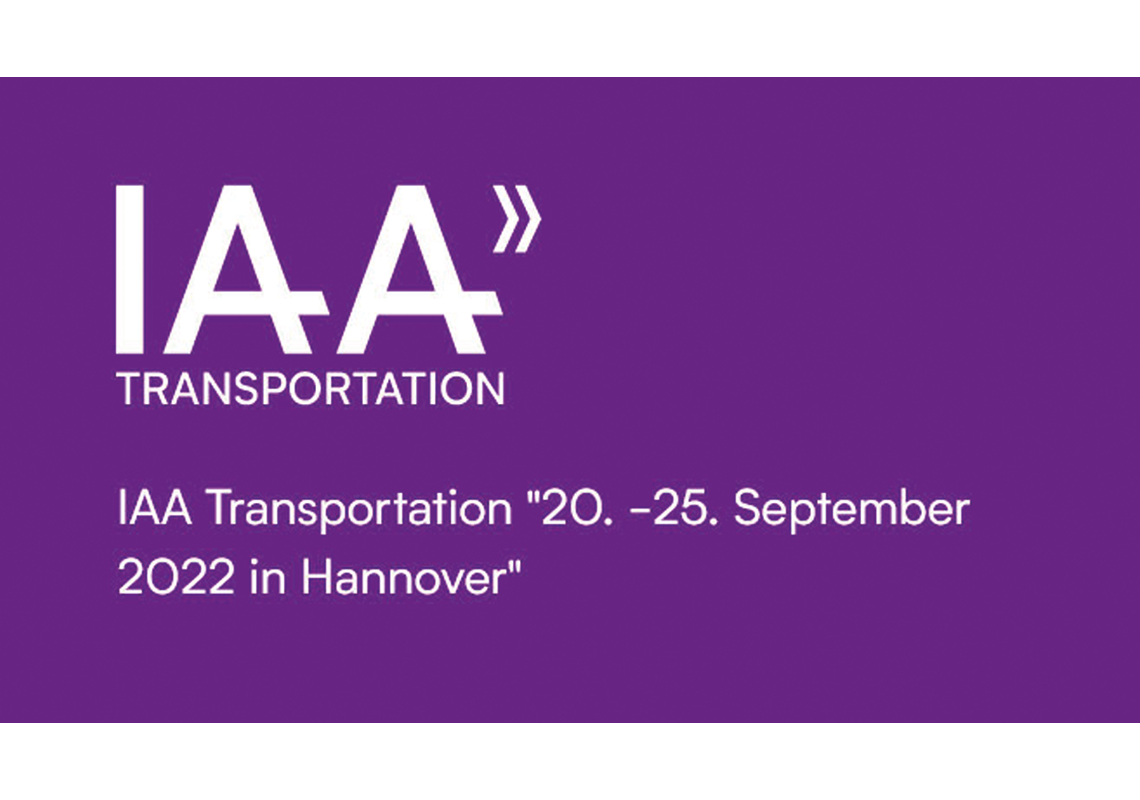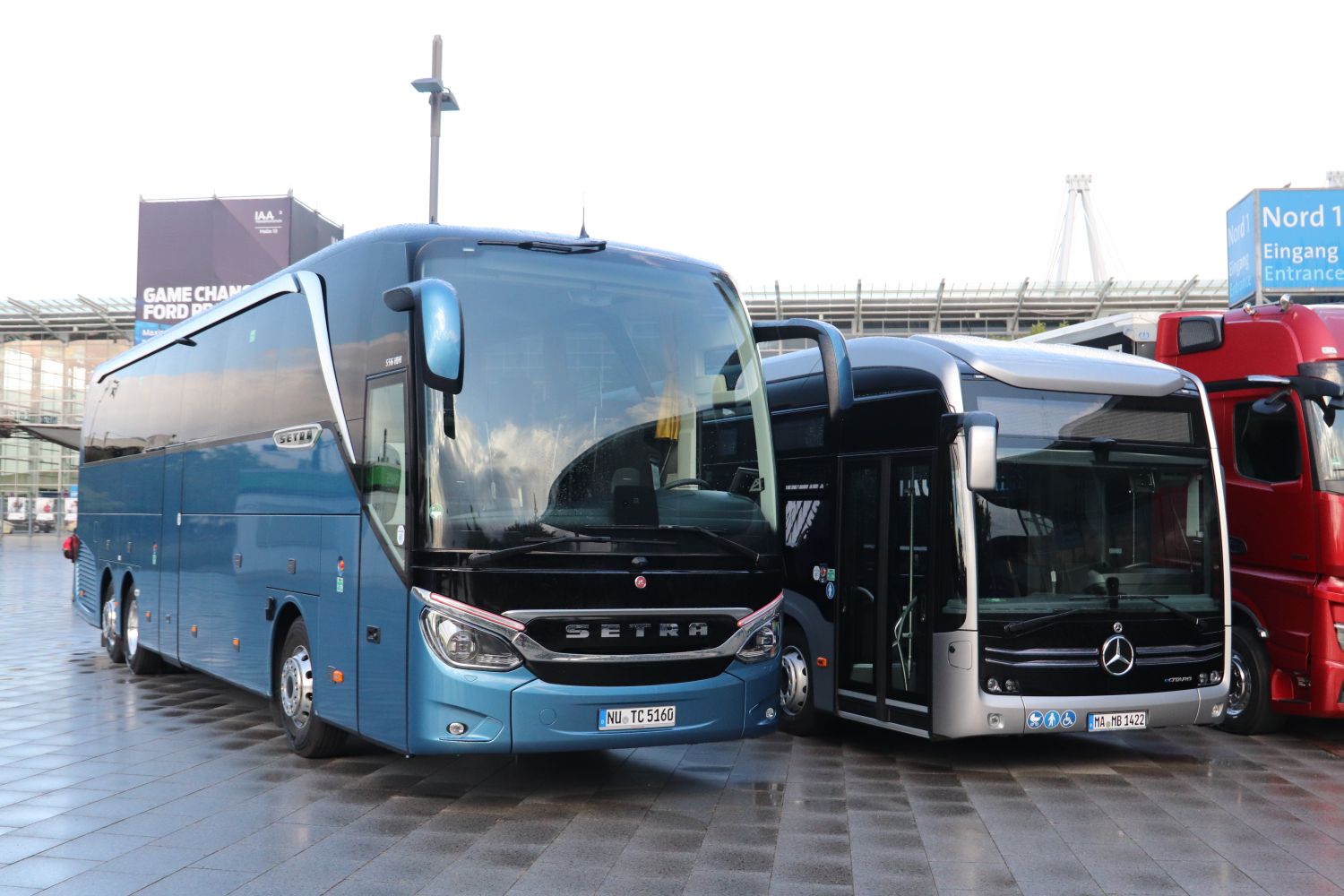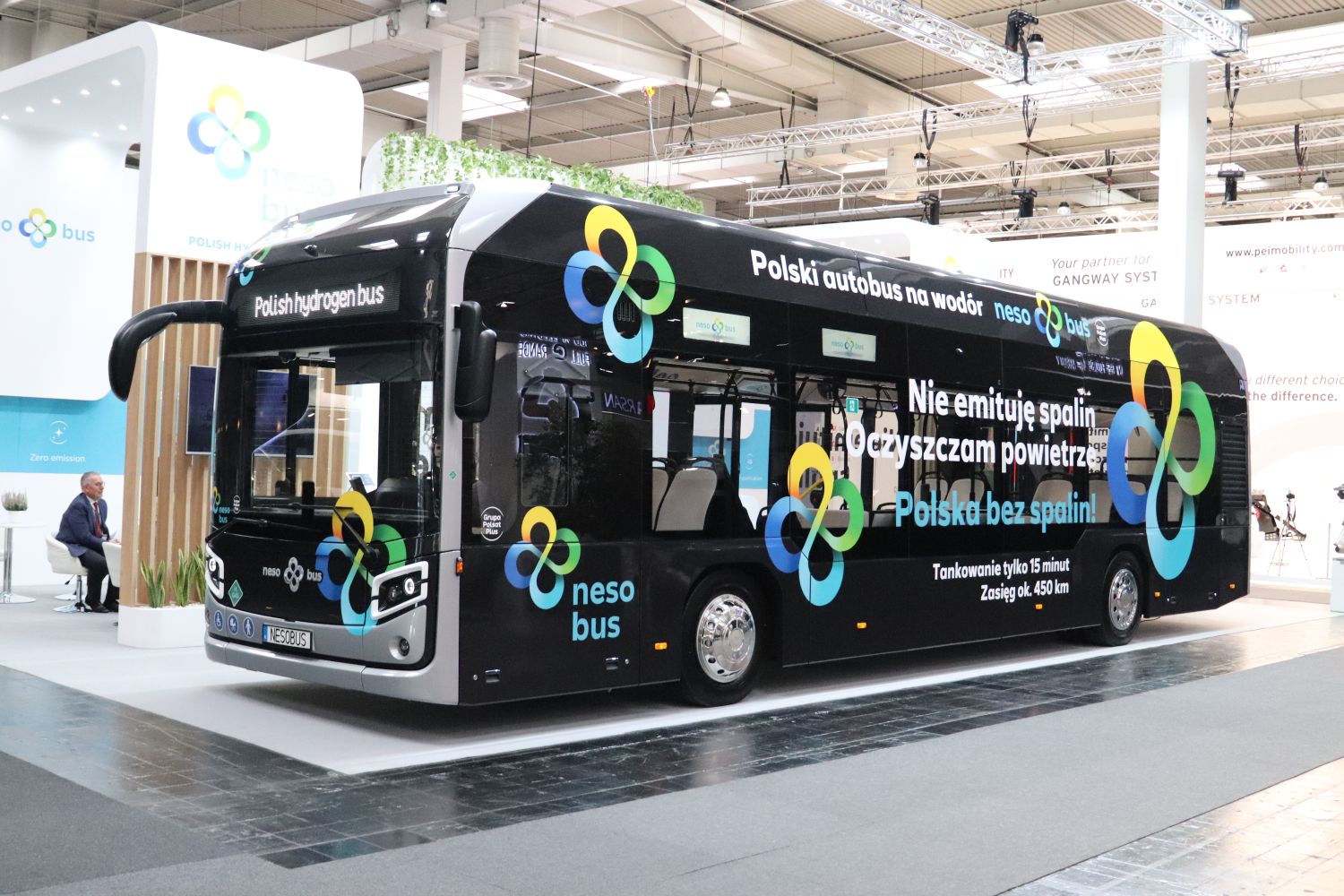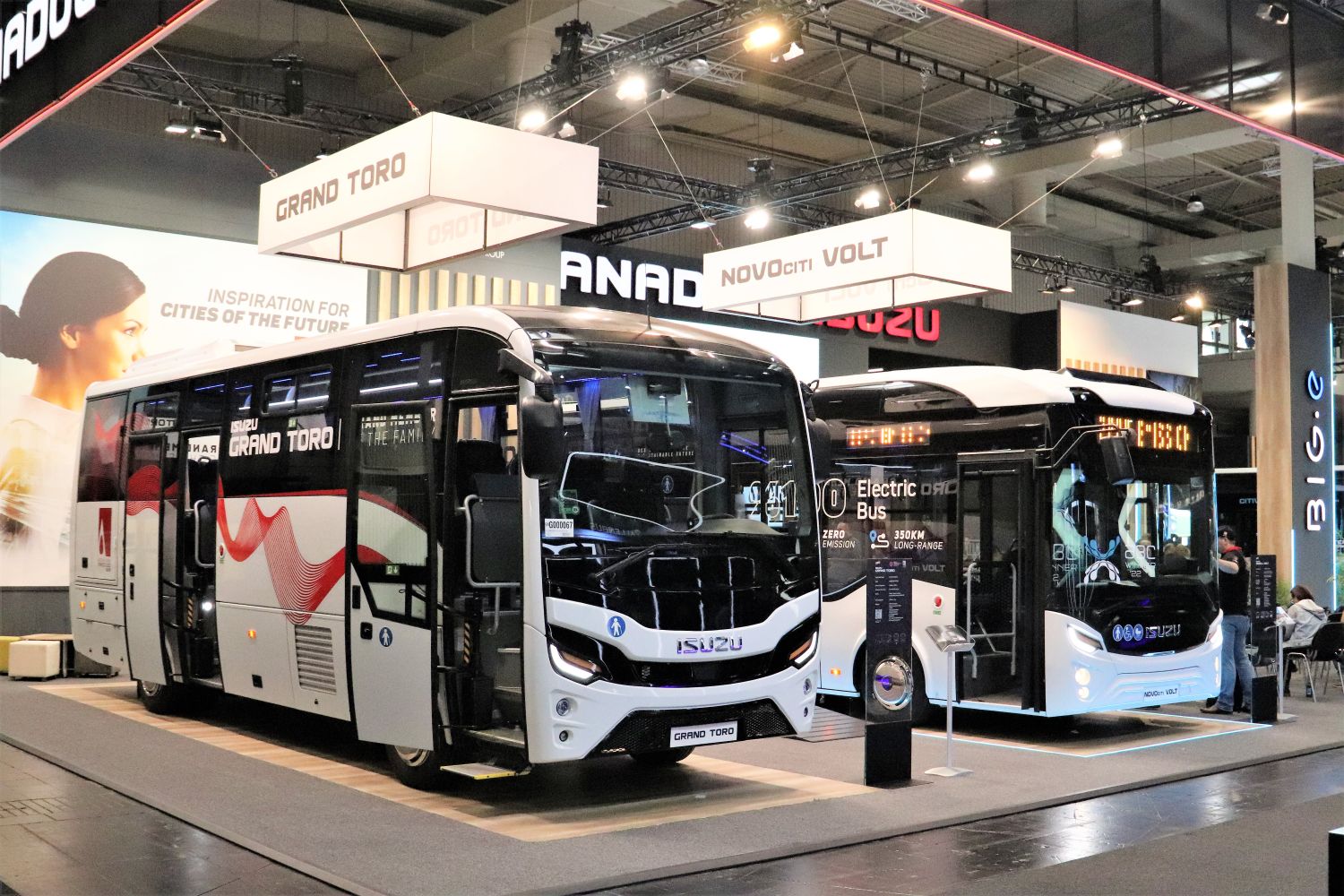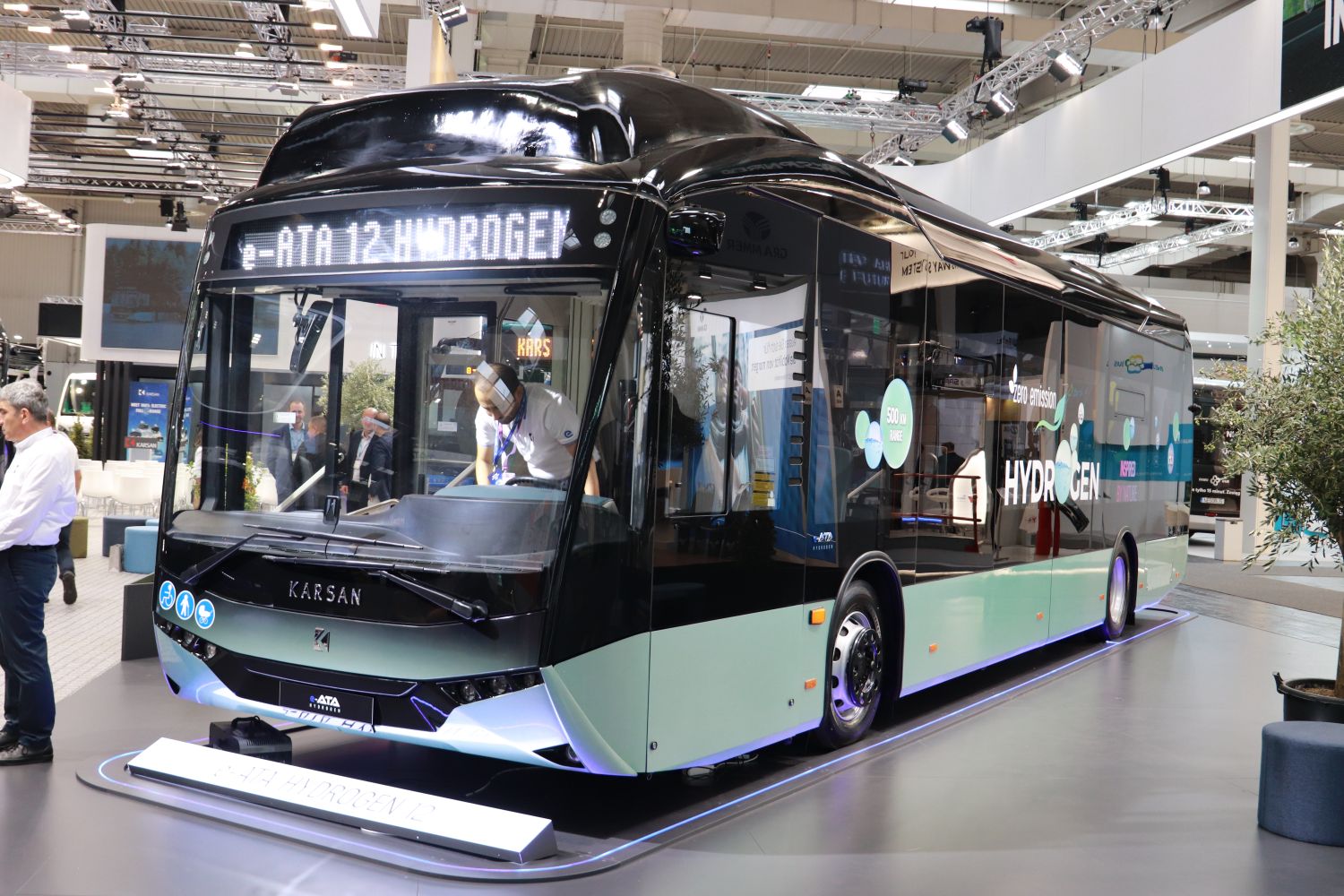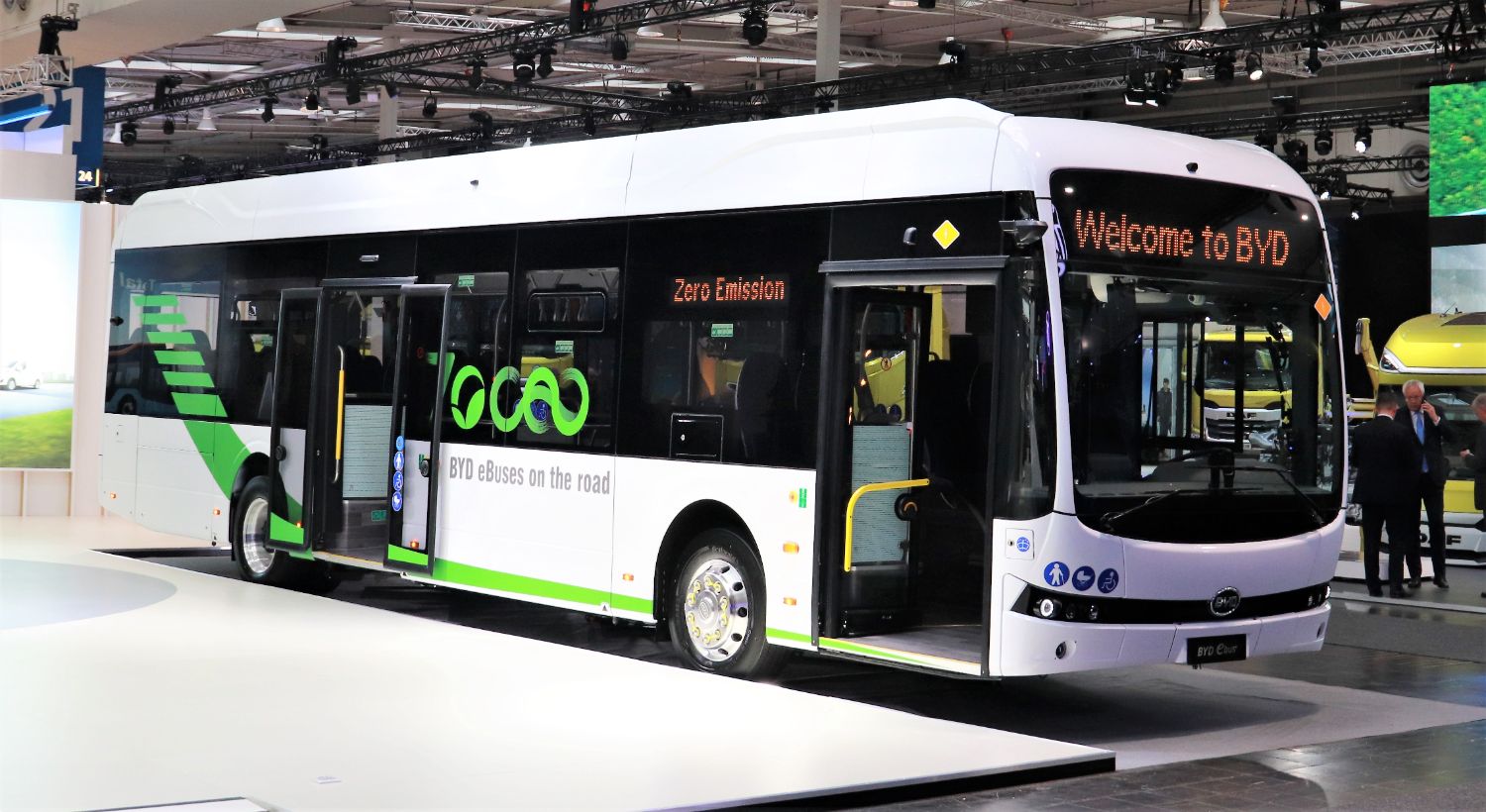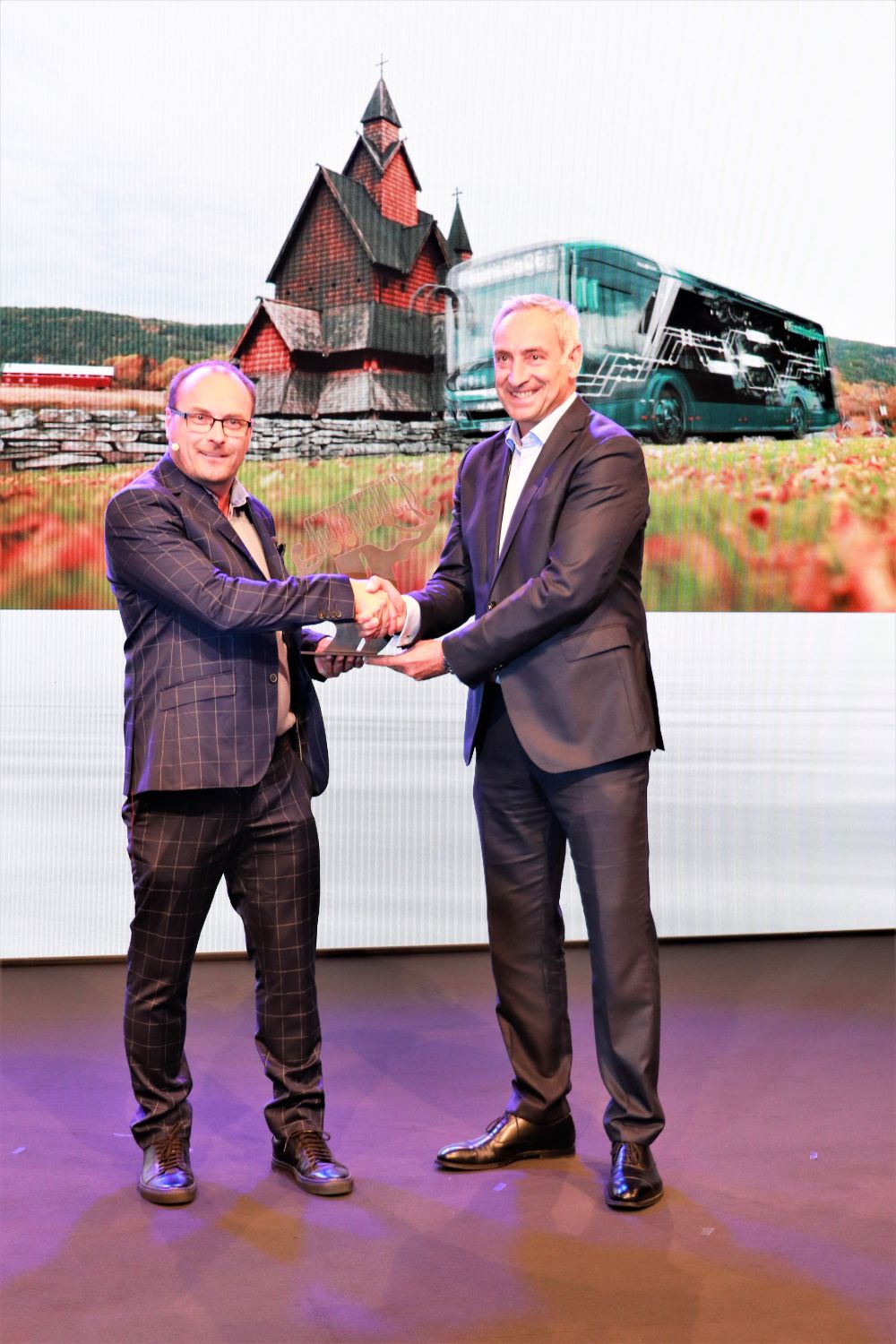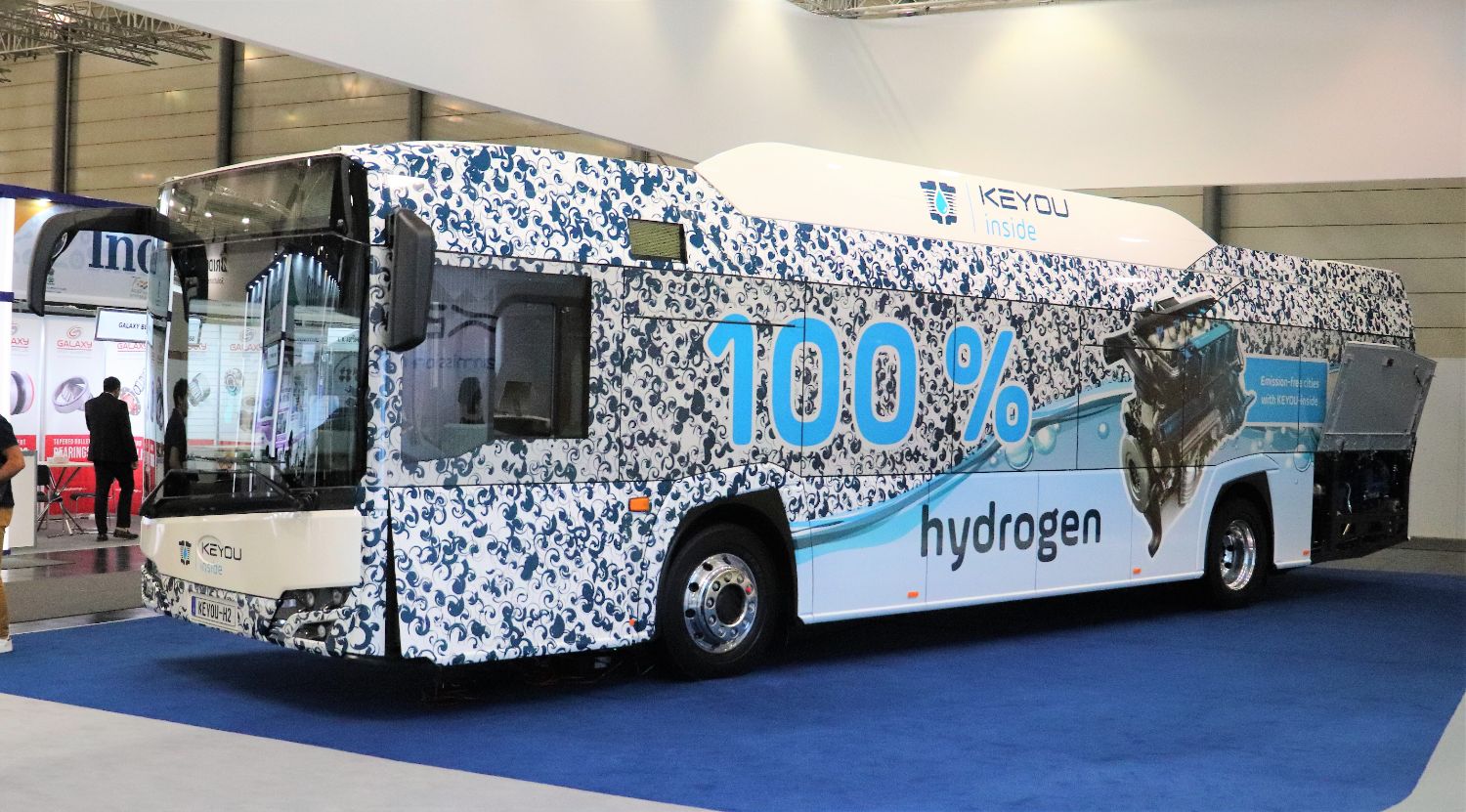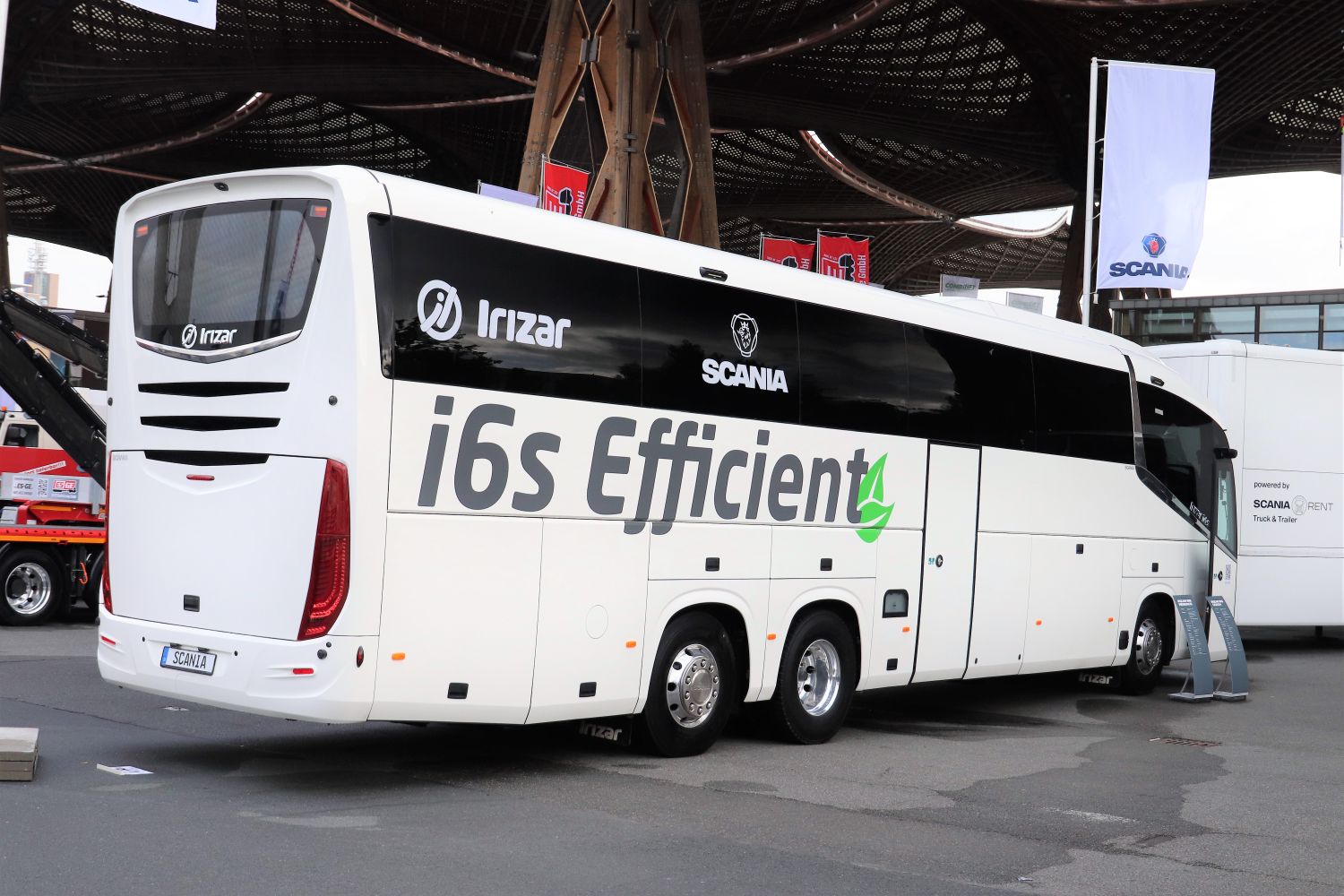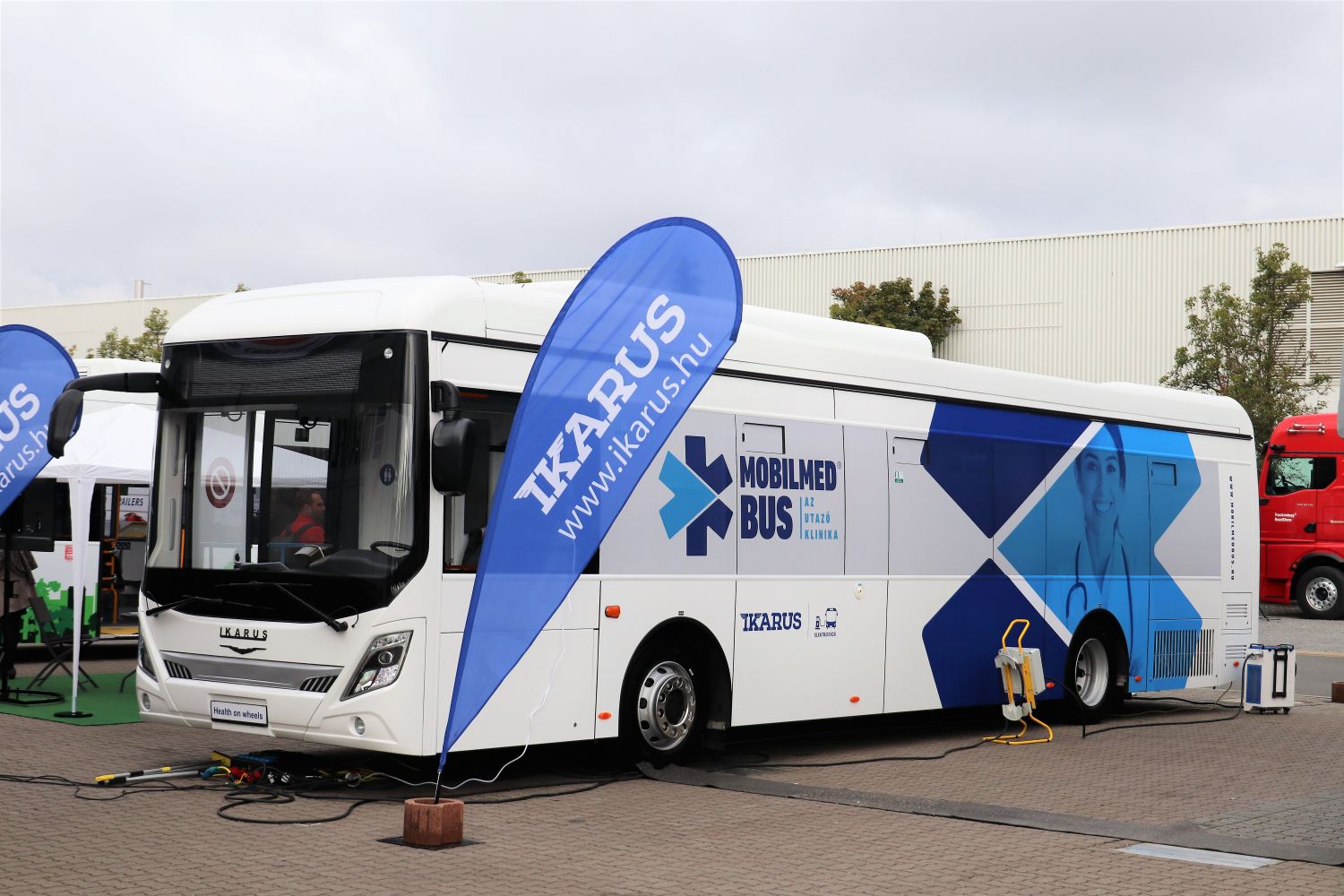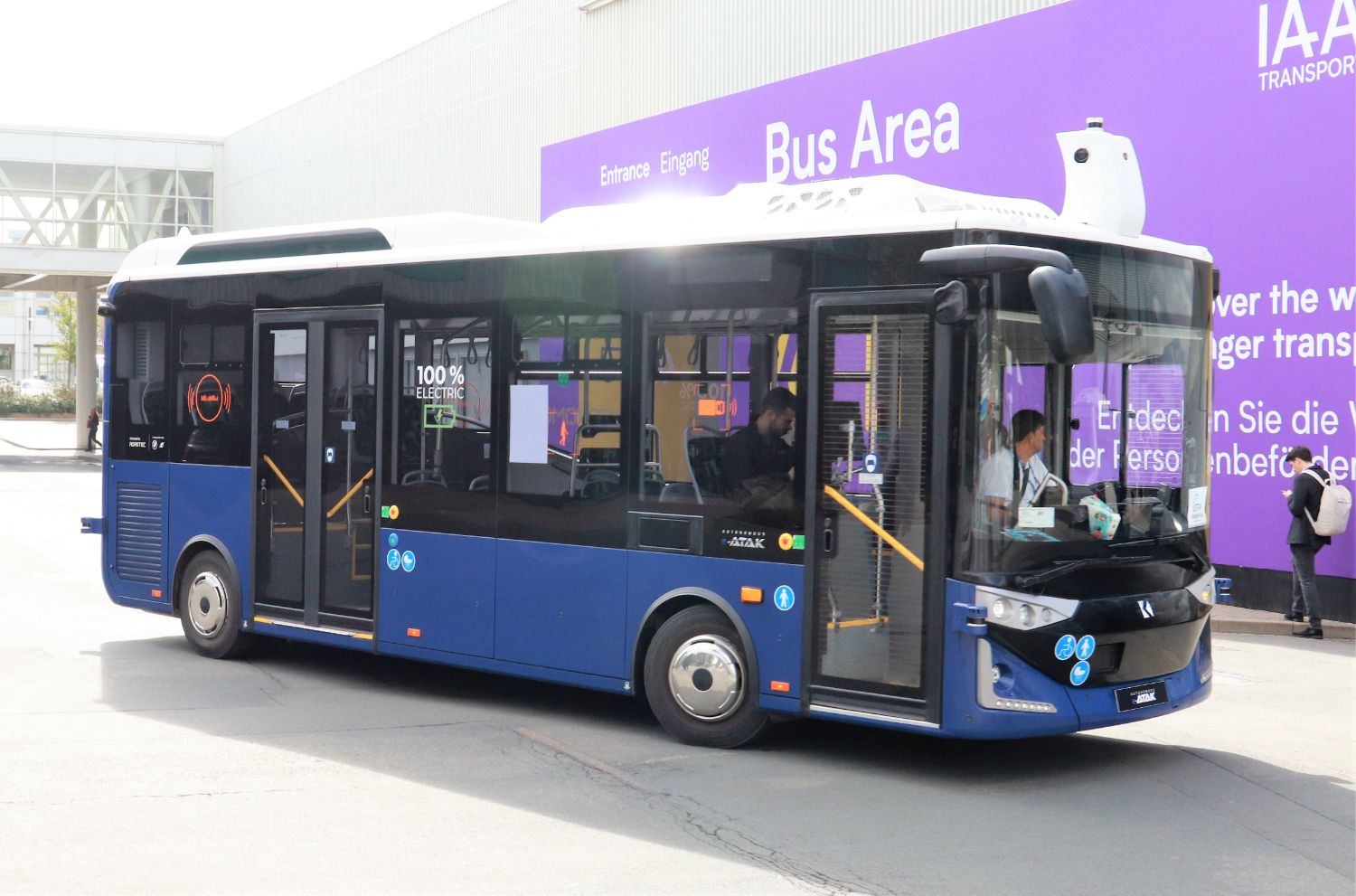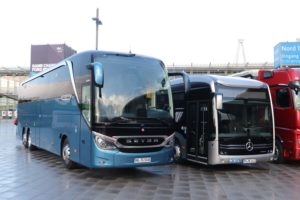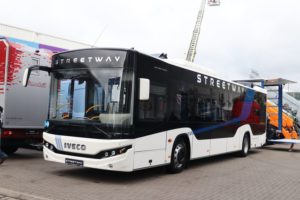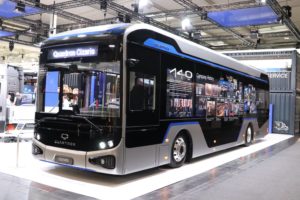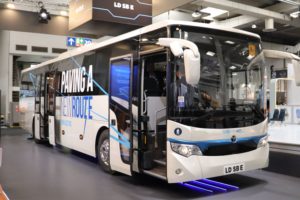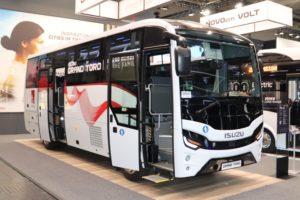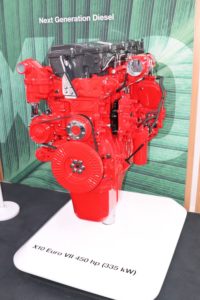Hidden gems
TO CYCLE THROUGH A FULL GALLERY OF IMAGES, CLICK ON THE BANNER IMAGE ABOVE
The four-year gap since the last IAA event in Hanover has seen the event change beyond all recognition. Many, indeed most of the major bus and coach manufacturers were either absent or had only a token presence with neither Daimler Truck nor MAN featuring buses on their inside stands and others choosing to launch new products at the Innotrans event in Berlin, the timing of which overlapped.
Though new fuels were a hot topic four years ago, most new products were still diesel then – this time the emphasis was overwhelmingly on electric or hydrogen and the associated equipment and infrastructure. While still international in its scope, there were not the cohorts of international bus and coach manufacturers exhibiting that there had been at past events, nor at bus specific shows such as Busworld. Of those that were there, Turkish manufacturers and converters were disproportionally well represented.
Nevertheless, there was a great deal positive and interesting to see including manufacturers I had never heard of previously and products brimming with new innovations.
Vehicles
Daimler
At one time, a major upgrade of the Setra Top Class and Comfort Class coach ranges would have been a huge deal at the IAA but the new models were not on the Daimler stand, though a number were to be encountered in the demonstration area and where they could be experienced from both a driver and passenger perspective. Externally the changes are largely cosmetic with new bolder rear lights, a new grille and a ‘character’ logo treatment on the side, but underneath there are some significant technological advances.
These include Active Brake Assist 5, said to be “the world’s first emergency brake assistant that can respond to moving and stationary pedestrians with maximum full-stop braking” and Active Drive Assist 2, which “enables semi-automated driving in a touring coach for the first time,” because all of the vehicle’s assistance systems work hand in hand. This includes: braking, acceleration, maintaining distance, steering, maintaining lane integrity, and, for the first time, emergency stops. In order for Active Drive Assist 2 to function, a minimum lane width is required. If the system reaches limits such as unclear lane markings, excessively narrow lanes or excessively tight curve radii, it switches to passive mode. This is accompanied by a warning to the driver, with a corresponding display in the cockpit. Despite the support provided, the driver always remains responsible. Also new are an electronic parking brake, a 360° camera system to increase safety, keyless start and brighter full LED headlights and high beam assistant. In total there are six ComfortClass HD models and three TopClass HDH models plus a double-decker.
The forward plan for the development of the Citaro was announced some time ago, and the latest stage sees the Mercedes-Benz eCitaro equipped with Akasol NMC°3 high-performance lithium-ion batteries giving increased range and capacity. The new technology will be introduced gradually and first examples equipped with it will be delivered before the year end. Though opportunity charging is possible, the intention is that the capacity will be sufficient for NMC°3 equipped buses to only require overnight depot charging. Cells in the new batteries have a high-energy NMC cathode, a liquid electrolyte and a graphite anode and are cylindrical rather than prismatic. Their improved chemistry and optimised packaging enables 50% more power to be delivered with the same weight of batteries. In total there are 600 cells in each battery and nine modules giving a total of 5,400 cells. The number of packs can be specified depending on application: a two axle Citaro would have between four and six battery packs (maximum) with a total capacity of up to 588 kWh. As well as the e-Citaro it will be offered in the eCitaro Range Extender and in the Brazilian eO500U chassis.
The next step for the eCitaro for 2023, will be the eCitaro Range Extender with Toyota fuel cell and modular hydrogen tanks. It will have a 400km range (12m, 18m is 350km) and use waste heat from the fuel cell for its thermal management. It uses gaseous hydrogen at 350 bar pressure.
A new hybrid option is the 10.75m Intouro K. Along with the new hybrid unit it comes with either a 220 kW (299 hp) or 260 kW (354 hp) diesel engine and a choice of: six-speed manual transmission, fully automated Mercedes-Benz PowerShift transmission or automatic transmission with torque converter from Voith or ZF. It has a 48-volt system and supercapacitors are used for short term energy storage.
MAN
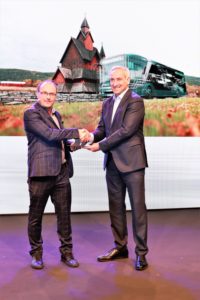
Jury Chairman Tom Terjesen presents MAN’s Rudi Kuchta with the International Bus of the Year 2023 trophy won by the Lion’s City 12E
MAN did not show buses although there were quite a few of the current range operating on the shuttle service around the site. However, the event was noteworthy for the company as during the ‘Stars of the Event’ evening they were presented with the International Bus of Year 2023 Award following the performance of the Lion’s City 12E 12m electric bus in the Bus Euro Test held earlier this year in Limerick. The bus made the 2,500km journey there under its own electrical power, recharging, when necessary, on the way.
“The new MAN Lion’s City 12 E has a ground-breaking design, high grade of comfort and a very quiet area inside. The driver’s cabin is one of the best on the market and with high level of safety. MAN has focused on electric mobility from the first drawing and to the end product. In that way everything fits together and is not a ‘diesel bus converted to electric’. The International Bus & Coach of the Year Jury had a positive feeling from the first test drive up to the decision that MAN Lion’s City 12 E is the Bus of the Year 2023”, said Jury President, Tom Terjesen, who presented the trophy to Rudi Kuchta, head of the MAN bus division.
As well as the 12m Lion’s City 12E, MAN has now introduced a shorter 10E model, increasing the electric portfolio. Perhaps surprisingly, given the enthusiasm for it shown by many other manufacturers, there are no current plans for a hydrogen fuelled Lion’s City. Talking to Rudi Kuchta, he was clear that MAN would not be going down the hydrogen path.
Scania
Scania placed the bus centre stage with a battery electric Citywide 4×2 two-door city bus on the stand. This featured a 300kW (peak) electric machine. It had an installed energy capacity of 330kWh and could be charged at up to 150kW or 300kW if charged via an inverted pantograph.
A 57-seat Irizar i6S Efficient HDH bodied tri-axle coach also appeared on the company’s outside display area. This had the DC13.164 engine rated at 450hp and the Omnicruise GRS8095R transmission.
Iveco
I didn’t see the main Iveco stand but understand it included a 12m, two-door E-Way from the Heuliez range as well as the latest generation of the Daily, launched earlier this year and now additionally available as an electric. The E-Way now has 20% higher capacity Forsee Power ZEN NMC batteries for night charging. These are neither heated nor cooled and give a maximum on board capacity of 462kWh giving a maximum range of 400km. For those needing fast charging an LTO (Lithium Titanate Oxide) option is offered.
Outside was a 12m Streetway three-door city bus with FPT Cursor 9 8.7-litre diesel engine rated at 310hp engine and Voith Diwa 6 transmission. Iveco Bus is entering a strategic partnership with HTWO (a brand of Hyundai Motor Group) to equip its future European hydrogen-powered buses with fuel cell systems. There is also a new Memorandum of Understanding with VIA to explore possible future collaborations in the development of tailored on-demand public transportation solutions and associated digital services for autonomous on-demand shuttles.
BYD
There was only one complete bus on the BYD stand, a 12m eBus of the latest generation with more spacious interior. The company officially launched the eBus Blade Platform incorporating BYD’s Blade batteries which are said to be significantly safer and very durable. Now packaged in a more rigid structure using BYD’s CTP (cell to pack) technology, it halves the space required to install it enabling range to be extended by increasing the space available for packs to be installed. The overall weight of the bus is also decreased.
Ikarus
We haven’t heard much from it in the UK of late but the Ikarus brand continues to build buses in Hungary, though not on the epic scale it did during the Cold War era when it was the world’s biggest bus builder, building 32 a day on three shifts. The current rate is one a week. The plant now employs 200 people and is owned by Gabor Szeles. On an outside stand were two stainless steel framed electric vehicles, one a fully equipped 120E (Version 2) three-door healthcare bus and the other a 120E (Version 3) three-door service bus seating 30 with 55 standees. They feature 314kWh CATL LFP batteries and t-drive-MD2021 permanent magnet synchronous motors.
A strength is that delivery of existing models can be completed in as little as two months. A new Version 4 electric artic with fluid cooled batteries has been designed and will enter production next year and this will charge twice as fast as previously. The company can also supply diesel buses, 200 Volvo based buses have been delivered to the Hungarian military and prison services in the last two years.
Quantron
An interesting new Augsberg, German-based player is Quantron, although the parent company has 120 years experience in truck service and maintenance in Bavaria. Looking to the future it recognised the need to diversify away from diesel and started retrofitting electrification kits to existing vans, followed by trucks and buses.
With the likelihood that retrofitting will not be a sustainable market in the future it has now taken a further step to start offering its own new range, though conversions are still being offered in parallel. It linked up with the Wechai Group in China and they build on Quantron’s behalf, it isn’t a Wechai dealership. The first bus model is the 12.18m long, 2.55m wide, Cizaris 12EV which has CATL batteries, Dana axles and electric motor, Wabco/Bosch brakes and Valeo air conditioning. With over 5,000 already running in Asia it has proven its durability.
Each bus, and the vehicle shown was the first, is 80% complete when it arrives from China with the remainder of the work completed at Augsberg. It had a rigid front axle and generic dash layout but from the year end (for the German markets) it will be offered with a VDV dash and independent front suspension. Price for the most basic version in Germany with 242kW batteries is Euros320,000 (£279,610) and the show model with Kiel seats, 422kWh batteries, camera mirrors and other extras was Euros385,000 (£336,428). As well as the 242kWh and 422kWh options there are also 284 and 361kWh alternatives.
Batteries are guaranteed for eight years or 3,000 loading cycles. Under the strictures of SORT2 with the 422kWh option the range is 370km. Charging at between 80kW and 150kW needs three to four hours. Certified to 19tonnes GVW and capable of 19.5tonnes, it has an unladen weight of 13,030kg. Passenger capacity is up to 95 passengers, with the stand model holding 89 or 79 and a wheelchair. Next year an articulated 18m and a sub 12m model are envisaged. The Cizaris can be supplied in right hand drive (with a six-month lead time) and talks have been held with an Irish partner, though not as yet anyone from the UK. And if you want to convert your existing Iveco Daily to electric, Quantron will do it for you for between Euros60-90,000 depending on battery capacity required.
Temsa
Temsa was one of a number of manufacturers keen to stress the climate change agreements it has signed up to, and CEO Tolga Kaan Dogancioglu saw the answer to today’s many challenges in striving for sustainability and designing for the future.
Chief Sales & Marketing Officer, Hakan Koralp, pointed out that Temsa has an 18% share of the American coach market, offering four models there, and has supplied in excess of 5,000 buses and coaches in France. He also referred to the company’s relationship with the Czech PPF Group which has seen Skoda Transportation become a sister company, saying that the pair were now stronger and more determined in global markets, particularly with electrification solutions. The bodies of both Skoda exhibits at the Innotrans exhibition featured Temsa built bodies.
Future R&D will concentrate on electric options, evidence of which was the launch of a new 12m or 13m two door intercity/school vehicle called the LD SB E which seats 63 and features a 250kW electric motor and battery capacities of 210, 280 or 350kWh, giving it a range of up to 350km. The NMC batteries are made in house using Japanese cells. It can be charged in two hours with a 150kWh DC Charger. It can be built in right-hand-drive format if there is perceived to be a large enough market for it. With the launch of the LD SB E, the Temsa electric range grows to five models, including the US specification TS45E.
Anodolu Isuzu
Of enhanced relevance following the recent link up between the company and EVM UK Ltd, the stand featured a number of innovations several of which may well find their way to the UK in time. Heading up the project for EVM is Steve O’Neill, formerly of Irizar UK, who is enthusiastic about the brand’s UK prospects. Initially the two products will be the Grand Toro, an 8.51m long, 37 seat, mid engined integral with 4.5-litre Cummins iSB4.5E6E210B engine and Allison T3207RxFE six-speed automated manual transmission. It is expected to cost £130,000.
Slightly larger at 9.56m is the Visigo coach with 39 seats, 6.7-litre Cummins B6.7E6E250B engine, independent front suspension; and ZF Ecolife transmission, it sells at £170,000. A pre-production Visigo has been supplied to EVM’s Horsham headquarters and the first four examples of these have already been sold to three different customers. Steve said that, in addition to the existing EVM support team, ‘we are recruiting field engineers and an aftersales manager as well as increasing our service network.’ The Visigo can be fitted with a mid-mounted nearside lift if required but does not have a full continental door.
Other recent new products from the brand are the electric Novo Citi Volt, an 8m all electric midibus with a 350km range and the 13m Kendo CNG which can run on biogas. A brand new last mile electric delivery van called the Big-e was unveiled on the stand. I understand this will also be offered by Danny McGhee. The Novo Citi Volt bus will be making an appearance at the NEC show later this year.
Guleryuz
New to me, though I believe it first appeared at Busworld Asia, was the 8.58m Guleryuz EV Ecoline which has been developed for the US market and looked a very tidy product. It has a 250kW central drive unit from Danfoss developing 2370Nm of torque, six 50kW Lithium Ion batteries and independent front suspension.
Also shown was an EV Panora 11m open top double decker with retractable canopy, ZF AxTrax AVE electric hub motors and 280kWh Lithium Ion NMC batteries. It can be supplied in right hand drive; examples having been delivered to Cyprus. Completing the stand was the 9.8m Efora coach with Mercedes-Benz OM936LA 300hp engine and ZF manual transmission (auto is an option).
Karsan
The Turkish manufacturer, Karsan, has transformed itself in the last four years on an Electric Evolution journey, launching electric versions of the 6m long e-Jest, the 8m e-ATAK midi, and the 10m, 12m and 18m e-ATA. There is also the fully autonomous e-ATAK, examples of which are running in America at Michigan State University and in Stavanger in Norway. One was to be seen working on the press shuttle at Hanover. Sales have risen from 66 electrics in 2019, to 107 in 2020, 133 in 2021 and this year the figure will at least treble to in excess of 400.
New was the e-ATA Hydrogen, a full low floor 12m city bus which has a 70kW fuel cell, ZF 250kW hub motors delivering 22,000Nm torque and ancillary 30kWh LTO batteries. The 1,560 litre hydrogen tanks take seven minutes to fill and give a realistic range of 500km.
Neso Bus
You are unlikely to have heard of Neso Bus because it is a new company with links to the former Ursus concern. Owned by Zygmunt Solarz, a media tycoon and said to be the richest man in Poland, the brand showed its first new bus, a 12m hydrogen-fuelled city bus with Ballard stack, Hexagon tanks, Enika electrical systems, Actia driver’s systems, R&G monitors and ZF hub motors and axles. The stainless steel framed body had laminate side panels and a somewhat unusual interior with a capacity of 29 seats and 64 standing featuring a lot of white leather type material. The range is said to be 450km on 37.5kg of hydrogen. Also under development is a 12m bus with a central engine and a 18m hydrogen design.
The owner has in his portfolio several coal mines and is looking to diversify. He owns Zepac, a private supplier of hydrogen that wants to go all green energy by 2030 and this has placed an order for 15 hydrogen buses. Two months ago the company started building a new factory, initially to build 100 a year but with the capacity to go to 300. It should be complete by June 2023 and aims to supply 35 buses to the market in the year.
Sinosynergy/Allenbus/Feichi
Fascinating, as it was the first hydrogen fuel cell coach I can recall seeing, the solitary coach on this joint stand featured a Chinese built Marcopolo body. Mounted on a chassis platform produced by the linked Hong Kong based concerns of Feichi and Allenbus (Feichi’s export brand), it featured a Danfoss electric motor and a stack and other major power components from Sinosynergy, another Hong Kong registered company. All three concerns were showing in Europe for the first time. Founded in 2015, Sinosynergy’s fortunes have been linked to those of hydrogen in China where the Government is supporting the more widespread use of hydrogen in various sectors and sponsoring the establishment of fuelling points in cities. Sinosynergy has a two part business plan under which it aims to sell stacks to fuel cell system companies and provide total solutions, advising on all stages of the process from hydrogen manufacture to running fuel cells. It is seeking European partners it can work with to support and develop hydrogen. It has supplied over 5,000 systems for commercial road vehicles, two thirds of these in buses, working with a variety of other bus manufacturers. The 12m, 53-seat coach, which is the first of its type, is built to EU regs, weighs 13.5tonnes and has four 700-bar hydrogen tanks giving a 500km range. Six hydrogen tanks is an option. Representatives pointed out that as it can be refuelled in between five and ten minutes, it can replace diesels one for one in a fleet.
Minibus
Kutsenits
An ever present at European shows, Kutsenits specialises in city bus conversions, often of a quite radical nature, based on popular base units. On the stand was a Sprinter based electric minibus with low floor centre section. Next to it was one of Kutsenits’ E-Solar City L range based on a Toyota ProAce Elektro with low floor centre section. The company pointed out that more than 85 E-Solar City buses had now been sold. A further bus could be seen operating on the shuttle service around the site.
Erener Otomotiv
An Iveco Busmaster preferred convertor, Erener showed three different Dailys with Revolution conversions to T (touring), S (coach) and SU (intercity) specifications. The SU had coach seats, inset opening windows with large gazed side windows and a rear lowered wheelchair platform. Also displayed was a Sprinter mounted Grand-Efes coach.
Tekaydinlar
Based at Bursa in Turkey, Tekaydinlar, which also exports under the Sambus brand, now run by the second generation of the Tasocak family. It showed four minibuses which were the subject of extensive conversions but is capable of converting for any application. Centre stage was a Sprinter 519CDi with a lowered centre, single main passenger door, destination pod and side skirts while another Sprinter was a two door coach. On the Iveco Daily 70C18 a lowered centre area was incorporated with a capacity of up to 35 passengers (33 seated) while an MAN TGE 5.180 had a lowered rear section, both front and rear passenger doors and belted 2+1 seats as well as straphangers in the aisle. The company exports extensively and has an agreement with Harris in Ireland. It expects to announce a UK importer in the near future.
OV Steinborn/ Esref Karoser
Whilst my favourite coach on the Esref Karoser stand was a 1965 Setra S9 integral with Henschel engine, the company today is all about conversions of minibuses which are sold in German speaking markets by Steinborn Omnibusvertrieb of Ulm. Present were conversions of the Iveco Daily, VW, and a variety of Mercedes-Benz Sprinters including the 317CDi, 515CDi and 517CDi.
Gursozler/Stylebus
Based close to Istanbul’s Eastern airport, the Gursozler company is family owned and builds around 300 conversions annually employing 150 people. It supplies to a variety of international markets and plans to begin selling to Russia. Exhibits included a Vito 124 VIP with an orange/black Nappa leather interior for four and a Maybach body kit. Also shown were a Sprinter 519 Auto X-Long with 19 seats, 50cm rear extension and star ceiling and a 517 manual with very deep side windows, a rear extension incorporating a 300kg Liftsa lift and demountable coach seats.
Altas
An example of the Sprinter based Novus Electric appeared on the IAA stand with another Novus simultaneously exhibited at Innotrans in Berlin. The Lithuanian concern is already represented in the UK and Ireland through EVM and will be present in Birmingham in November. The Altas Novus Cityline LW has a 7.667m length as a result of a 70cm extension within the wheelbase. It has 115kWh batteries.
Power and Repower
Keyou
A surprise as I passed through the stand looking for something else was the stand of Keyou Inside, which featured a full sized Solaris 12m bus fitted with a 7.8 litre Q hydrogen fuelled internal combustion engine and Voith mild hybrid transmission. It carries 37kg of hydrogen at 350bar and has a range of 370km. COO, Markus Schneider told me that the Munich based company had developed its own retrofit conversion technology for any existing internal combustion engine of between 4 and 16 litres. The company is targeting existing fleets because by 2030 80% of the fleet will still be diesel and it is important to be cost efficient to keep business models working. It is currently working on the first two platforms, the 7.8 litre OM936 engine for mid-range applications and the Volvo D13 for heavy applications. It envisages providing mobility as a package (cost per km) basis and by the end of 2023 will have a fleet of trucks operating in this way. In 2024 it will start offering retrofits on existing vehicles with vehicles available from the end of the year.
IAV
Working on the exhibition shuttle was quite an old former Berlin two axle double decker which proclaimed ‘Electrified by IAV’ across the front. Though I tried I was never in the right place at the right time to catch it, so I’m afraid I can’t tell you more.
Cummins
Whatever the market wants, Cummins is putting itself in the right place to deliver it. Shown on the stand was a 15-litre fuel-agnostic engine platform which enables the same block to be used for Biogas, hydrogen and HVO engines, with only the head changing. The X15H for hydrogen appeared complete flanked by heads for the biogas and HVO versions. A 6.7 litre hydrogen engine was also displayed. Cummins will offer 6, 7 and 10 litre hydrogen options.
Worthy of note was the X10 EuroVII 450hp/335kW engine which weighs 810kg fully dressed and will eventually replace the current 8.9-litre unit. Producing 2,300Nm of torque, it is of a completely new design with a sculpted block, it offers a high power to weight ratio, ultra-low NOx and PM levels and significantly reduced CO2. It has a DPF and dual SCR system.
The company’s fourth generation fuel cell can be supplied as either a 135kW or a 270kW package. It is said to offer best in class fuel cell density. Cummins is working with both bus and truck partners and vehicles equipped with it will be on the road in 2023.
Following the acquisition of Meritor, a concept e-Powertrain appeared showing just how much of a system Cummins can supply.
ZF
Among ZF’s innovations were the integrated modular CeTrax 2 electric central drive for heavy-duty vehicles which could be suitable for coach applications. It has two high performance oil-cooled e-motors as well as two integrated 800 Volt silicon carbide (SiC) inverters, using a three-speed gearbox able to perform powershifts. The compact system enables diesel and electric drivelines to be installed on the same platform. ZF also demonstrates its advanced new Electric Power Steering (EPS) system for trucks, coaches and city buses, which is prepared for steer-by-wire and up to Level 5 autonomous driving. A new electric motor featured hairpin winding which allows higher power density within the same space.
Siemens
Illustrating the fact that infrastructure developments are every bit as important as vehicle ones in the future of sustainable transport, Siemens not only showed the latest Elfa electric system but also several charging systems under the Sicharge brand including a prototype one megawatt particularly fast charger designed to enable long distance commercial drivers to recharge a vehicle during a statutory break. A later version appeared on the Daimler stand. The Depotfinity product aims to provide digital solutions for electric depots to accelerate the transition from diesel to electric
